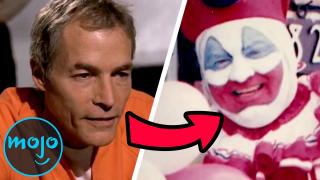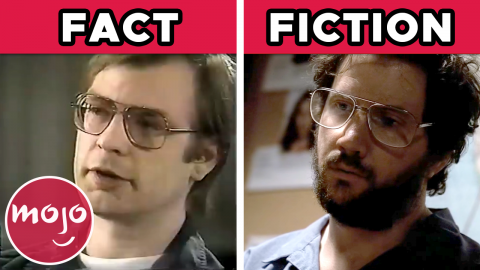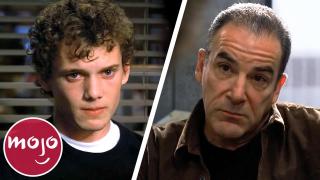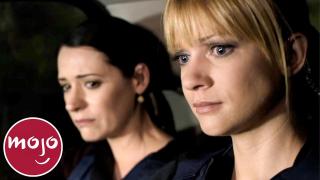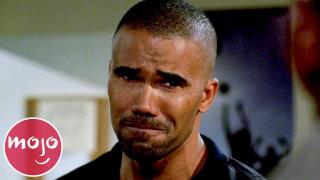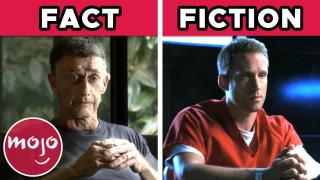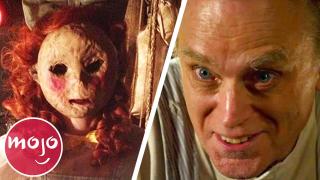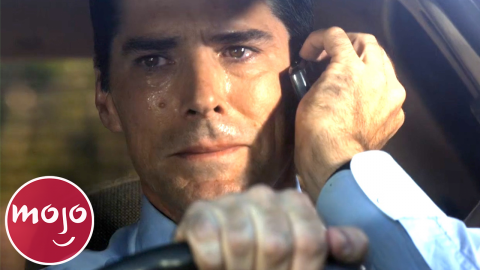Top 20 Criminal Minds Episodes Based on True Events
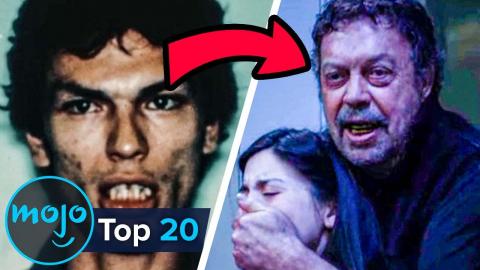
#20: “The Big Wheel”
Top 10 Criminal Minds Episodes Based on True Events
The antagonist behind “The Big Wheel” is serial killer Vincent Rowlings. Rowlings personally sends videotapes to the FBI and is seemingly unable to stop killing, despite a strong desire to do so. He bears many similarities to the unidentified Servant Girl Annihilator, but most of his influence stems from The Lipstick Killer. Like Rowlings, The Lipstick Killer also targeted women and deviated from his established M.O. But the strongest link comes through the killer’s need to repent. The Lipstick Killer directly corresponded with the authorities, writing at one crime scene, “For heaven's Sake catch me Before I kill more I cannot control myself” [sic]. This message was written on the wall in lipstick, leading to his now-famous moniker.
#19: “Identity”
This episode from Season Three concerns the serial killing duo of Francis Goehring and Henry Frost. Goehring is the mastermind behind the operation and the leading perpetrator, having killed four people. Frost is more of a submissive follower, having only killed one person himself. Virtually everything about this duo is taken from the real story of Leonard Lake and Charles Ng. Like Goehring and Frost, Lake and Ng targeted women and took them to an isolated compound. Goehring personally shares many similarities with Leonard Lake. Lake also made home videos espousing harmful and misogynistic beliefs, and he was also in the Armed Forces. Finally, like Goehring, he took his own life before he could be charged.
#18: “The Boys of Sudworth Place”
Top 20 Real-Life Crimes that Inspired Criminal Minds
Jack Westbrook is a successful lawyer who goes missing and is eventually targeted by Chad Griffith, Andrew Ford, and Brian Stiller. As we and the BAU learn, these boys were once harassed by Jack, who is actually a prolific abuser. As the BAU points out, Jack bears many similarities to molester Jerry Sandusky. Like Jack, Sandusky seemed like an upstanding member of society. He was a longtime football coach at Pennsylvania State and won numerous awards in that capacity. He also started and ran a charity called The Second Mile, which supported underprivileged children in Pennsylvania. But Sandusky was later arrested and found guilty on 45 charges. He is currently serving 30 to 60 years in prison.
#17: “The Tribe”
Top 10 Best Criminal Minds Episodes
The titular “tribe” in this episode is run by a man named Jackson Cally. His small cult used Native American rituals to kill their targets and seemed intent on starting a race war. The tribe killed eleven people, including six at the Minton residence. Jackson Cally is modeled after Charles Manson, and his tribe after The Manson Family. Manson also used brainwashing techniques to amass followers, and he was also intent on starting a race war. His cult also resided in the desert at an old movie set called Spahn Ranch. Finally, the Minton family massacre bears many similarities to the infamous Tate–LaBianca killings, in which members of the Manson cult broke into homes and killed the occupants.
#16: “JJ”
Top 10 Saddest Criminal Minds Episodes
This episode is centered around a store clerk named James Barrett. James kidnaps Kate Joyce from her hotel room, drives her out to the open ocean, and dumps her overboard with the hope that she will be eaten by sharks. The plan fails, and James is eventually arrested. The story of James Barrett is based on that of Dutch killer Joran van der Sloot. It’s believed that van der Sloot kidnapped and killed a woman named Natalee Holloway back in 2005. The leading theory is that he snatched Holloway from her hotel room, took her out to the open ocean, and threw her overboard. Unlike Kate Joyce, Holloway did not survive. While never officially convicted for this, he was sentenced for Stephany Flores Ramírez’s murder.
#15: “The Capilanos”
Top 20 Saddest Criminal Minds Episodes
Any time you see a killer clown, you can be sure that they’re modeled after John Wayne Gacy. “The Capilanos” details the story of Sal Capilano, a burglar and serial killer who dresses as a creepy clown. This is an obvious reference to the Killer Clown himself. Like Capilano, John Wayne Gacy had a horrible childhood with a violent father. Most famously, Gacy worked as a clown. He created the characters of Patches and Pogo and performed as them at numerous public functions. But, unlike Sal Capilano, Gacy did not dress as a clown while committing his killings. Rather, a plain-clothed Gacy would lure young men to his house, often with the promise of a job, and kill them there.
#14: “Omnivore”
George Foyet is a recurring antagonist throughout the early seasons of “Criminal Minds,” serving as a very prolific mass killer with a body count of 36. He first appears in the fourth season episode “Omnivore,” having restarted his killing after a prolonged hiatus. Foyet was modeled after numerous serial killers, with the BAU comparing him to Dennis Rader (also known as BTK) and the Zodiac Killer. However, his crimes also mirror the Phantom Killer of the Texarkana Moonlight Murders, David Berkowitz AKA Son of Sam, and the Boston Strangler. Finally, Foyet compares himself to Ted Bundy. Basically, George Foyet is a freaky amalgamation of all the major American serial killers.
#13: “The Company”
Top 10 CSI Episodes That Mirror True Events
This seventh season episode continues the story from “Big Sea,” featuring Morgan’s sister, their cousin Cindi Burns, and his Aunt Yvonne. Their journey takes them to a stalker and killer named Malcolm Ford, who abducted Cindi and killed John Hitchens. This story greatly mirrors the kidnapping of Colleen Stan, which occurred from 1977 to 1984. Stan was abducted by married couple Cameron and Janice Hooker and was routinely abused while imprisoned inside a small box. The real story also involves the signing of a contract placing the victim into lifelong servitude and the involvement of a fictional “Company” that prevented them from escaping.
#12: “Hostage”
The titular hostage in question probably refers to Gina Bryant, who escapes from a suburban house and gets help for the two other captors trapped inside. The investigation leads the team to one Michael Clark Thompson, a repairman who abducted Gina, Amelia Hawthorne, and Sheila Woods. He was also known to abuse Amelia and fathered two children with her, named Lily and Jasmine. As Rossi points out, this case is a virtual recreation of the Ariel Castro kidnappings. Castro also kidnapped three women - Michelle Knight, Amanda Berry, and Georgina DeJesus - and fathered a child with Berry. And, like the episode, Berry escaped from the Cleveland house and rescued the other two prisoners.
#11: “A Shade of Gray”
Top 20 Times Spencer Was the Best Character on Criminal Minds
Danny Murphy is a sociopathic child with severe anger issues who kills his younger brother. This homicide is then covered up by Detective Bill Lancaster, who frames a known criminal. It’s likely that this story was at least inspired by JonBenét Ramsey. The murder remains unsolved to this day. However, some have pointed the blame at Ramsey’s older brother, Burke. They believe that an angry Burke accidentally took her life and that the homicide was covered up. It’s very important to note that Burke has never been officially charged, or even considered a viable suspect. However, it’s clear that this episode takes inspiration from the media-fueled story, regardless of its veracity.
#10: “Natural Born Killer”
This first season episode concerns a professional hitman by the name of Vincent Perotta who is often hired by mob bosses. After kidnapping his victims, Perotta would inflict pain and suffering on them, and then dispose of their various body parts. This fictional hitman is inspired by Richard Kuklinski, who is perhaps better known as The Iceman. Like Perotta, The Iceman allegedly worked as a hitman for the mob, preferred male victims, was tormented as a child, and had a personal vendetta against his father. Unfortunately, the crimes of Kuklinski are hard to corroborate, as he is known to exaggerate. He was officially convicted of five murders, including the death of a police officer with connections to the mafia.
#9: “Broken Wing”
In Season 14, a nurse by the name of Douglas Knight injected his victims with opioids and masked their deaths as tragic overdoses. By doing so, he successfully evaded both suspicion and capture. At least for a little while. The character of Knight is heavily influenced by Donald Harvey, an angel of death from Ohio who worked as a hospital orderly. Unlike Knight, Harvey did not have a single modus operandi. Rather, he was known to harm his victims through a variety of methods, including cyanide poisoning, suffocation, shutting off ventilators, and injecting HIV into his victims’ bodies through tainted fluids. While Harvey was officially convicted of 37 deaths, the true number could be as high as 57.
#8: “Cradle to Grave”
Season 5’s “Cradle to Grave” is certainly one of the most upsetting episodes of “Criminal Minds.” It follows Arizona couple Robert and Linda Reimann, who kidnap young women, impregnate them, steal the resulting babies to raise as their own, and then dispose of the victims. This story is loosely based on the kidnapping of Oregon woman Colleen Stan. Stan was hitchhiking in 1977 when she was abducted by Cameron and Janice Hooker and subjected to similar horrors. She finally escaped in 1984. Cameron was sentenced to 104 years, and Janice was granted full immunity for testifying at his trial. Aside from “Cradle to Grave,” the case also inspired the movie “The Poughkeepsie Tapes.”
#7: “The Perfect Storm”
Top 10 Criminal Minds Episodes That Kept Us Up At Night
Amber and Tony Canardo of Season 2’s “The Perfect Storm” have many real-life precedents. One is Ian Brady and Myra Hindley, a couple responsible for five youth deaths around Manchester, England between 1963 and 1965. Another influence is David and Catherine Birnie, who abducted and murdered four in Western Australia in 1986. A fifth victim escaped and led the authorities to their location. But the DVD commentary reveals that the biggest influence on the episode was the case of Paul Bernardo and Karla Homolka. This was a Canadian couple who kidnapped and murdered numerous people in the early ‘90s, including Homolka’s younger sister, Tammy.
#6: “Ashes and Dust”
Another episode from Season 2, “Ashes and Dust” concerns serial arsonist Vincent Stiles. A pharmaceuticals salesman by day, Stiles would sneak into the homes of wealthy businessmen, douse the place in kerosene, and set a fire with a lighter. He would then watch the families burn while wearing protective equipment. This story is loosely based on the case of Paul Kenneth Keller, a serial arsonist from Washington who is directly mentioned in the episode itself. Keller set over 100 fires and caused $30 million in damage between 1992 and ‘93. In the fall of ‘92, Keller set fire to a Seattle retirement home, resulting in multiple senior deaths. He is currently serving 107 years in prison.
#5: “The Thirteenth Step”
Differences Between Criminal Minds and Criminal Minds Evolution
Ray Donovan and Sydney Manning were the subjects of the sixth season episode “The Thirteenth Step.” Hailing from North Dakota, these two terrorized the northwestern United States. The couple committed multiple mass shootings, causing numerous deaths at gas stations and an Alcoholics Anonymous meeting. While the duo shares some similarities with Charles Starkweather and Caril Ann Fugate, they were mostly influenced by the legendary crime spree of Bonnie and Clyde. They too targeted rural gas stations and claimed upwards of 13 lives, including nine police officers. And like Ray and Sydney, their spree also ended in a hail of gunfire.
#4: “Riding the Lightning”
To “ride the lightning” means to be executed by the electric chair. In this case, it directly references the fates of Jacob Dawes and Sarah Jean Mason. Dawes kidnapped females and tormented them in his personal workshop before burying their remains on the property. His wife, Sarah Jean, did not take part in the deaths, but also did nothing to stop her husband. Dawes shares many similarities with John Wayne Gacy. He too targeted one specific gender (contrary to Dawes, he only targeted males), and he also buried his victims under his house.
#3: “To Hell and Back”
Top 10 Most Heartbreaking Criminal Minds Moments
Serving as the two-part fourth season finale, To Hell and Back concerns murderous brothers Mason and Lucas Turner. Mason is the leader of the operation, manipulating his mentally disabled brother into committing dozens of crimes. Their horribly violent crime spree culminated in a staggering number of deaths. They shared a lot in common with Robert Pickton. Both committed their crimes in Canada, both were pig farmers, and both used their barn animals to dispose of their victims’ remains. They also targeted lonely people like sex workers and drug addicts to prevent high-profile attention.
#2: “Minimal Loss”
The fourth season episode “Minimal Loss” is a little different. Rather than focusing on one or two specific criminal minds, it concerns an entire cult and its eccentric leader. The cult is the Separatarian Sect, whose compound is located in rural Colorado. Its leader is predator Benjamin Cyrus. Cyrus is mostly based on famous cult leader Jim Jones, who oversaw the Peoples Temple. Like Cyrus, Jones made his followers drink poison. And while Cyrus’s poison scheme was a bluff, Jones’s wasn’t, and hundreds of Peoples Temple members died on November 18, 1978. The disastrous hostage crisis at the rural compound also shares many similarities with the deadly Waco siege of 1993, which resulted in the deaths of many Branch Davidians.
#1: “Our Darkest Hour” & “The Longest Night”
Top 10 Best Derek & Spencer Moments on Criminal Minds
Turning in his scariest performance since Pennywise in this 2-parter, Tim Curry portrayed Billy Flynn, who is nicknamed The Prince of Darkness owing to his penchant for taking lives in the dark. He would usually strike during a rolling blackout, breaking into a house and murdering most of its occupants. The influences behind Flynn are many, but he is largely based on two specific people. The first is Gordon Cummins, who struck during wartime blackouts and claimed the lives of four women in 1942. The other is Richard Ramirez, AKA The Night Stalker. Both he and Flynn had horrible teeth, both broke into homes in the dead of night, and both were accosted by a gang of angry civilians.


